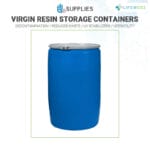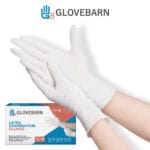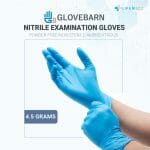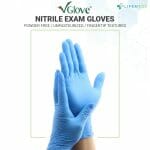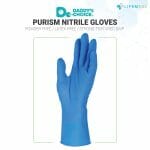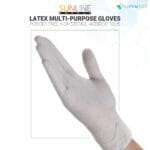What are Powder-Free Gloves?
Powder-free gloves are a type of disposable glove that does not contain the powdered coating found in some other types of gloves, such as powdered latex or powdered nitrile gloves. The powder is usually made from cornstarch and is added to make gloves easier to put on and take off. However, powder-free gloves are preferred in environments where there is a risk of contamination or allergic reactions, as the powder can cause irritation, respiratory issues, or leave residue on surfaces. Powder-free gloves are commonly used in healthcare, food service, and laboratories.
Why Powder-Free Gloves Matter in the Enterprise Environment
Powder-free gloves are essential in industries where cleanliness, safety, and preventing cross-contamination are critical. In healthcare settings, powder from gloves can interfere with medical procedures, and in laboratories, it can contaminate sensitive experiments. In food service and food processing industries, powder-free gloves prevent contamination of food products, ensuring hygiene and safety. Enterprise software solutions can help organizations manage the procurement, distribution, and usage tracking of powder-free gloves, ensuring that employees have access to the right type of gloves and reducing risks of contamination or allergic reactions.
Benefits of Powder-Free Gloves
Powder-free gloves offer several advantages, particularly in environments where hygiene and contamination control are critical. Some of the key benefits include:
- Reduced Risk of Allergies: Powdered gloves can trigger allergic reactions in some individuals, particularly those sensitive to latex. Powder-free gloves minimize the risk of skin irritation and respiratory issues caused by airborne particles from the powder.
- No Residue: The absence of powder means there is no residue left behind on surfaces or equipment, which is particularly important in environments like laboratories, cleanrooms, and food preparation areas.
- Regulatory Compliance: Many regulatory agencies, including the FDA, have imposed restrictions on the use of powdered gloves in healthcare settings due to concerns about contamination and adverse reactions. Powder-free gloves help businesses stay compliant with these regulations.
- Suitability for Sensitive Applications: Powder-free gloves are ideal for tasks that require a high degree of cleanliness and precision, such as surgeries, laboratory experiments, and food handling.
The Role of Enterprise Software in Managing Powder-Free Gloves
For organizations that rely on powder-free gloves, ensuring proper supply and usage is crucial for maintaining safety and hygiene standards. Enterprise software solutions can help businesses track the availability and consumption of powder-free gloves, automate the reordering process, and manage distribution across multiple departments or locations.
These software tools can also assist in compliance tracking, ensuring that the use of powder-free gloves meets industry standards and regulatory requirements. In healthcare and food service industries, where the risk of contamination or allergic reactions is high, enterprise software can monitor glove usage and provide data on glove types, helping businesses make informed decisions about their protective equipment.
Powder-Free Gloves vs. Powdered Gloves
While both powder-free and powdered gloves offer protection for hands, they differ in terms of comfort, ease of use, and specific applications. Here’s how powder-free gloves compare to powdered gloves:
- Powder-Free Gloves: These gloves are free from any powder, making them suitable for environments where contamination is a concern. They are ideal for healthcare, laboratory work, food service, and cleanroom environments. Although they may be slightly harder to put on compared to powdered gloves, they eliminate the risk of powder-related contamination and allergic reactions.
- Powdered Gloves: These gloves contain a cornstarch powder that makes them easier to don and remove. However, powdered gloves have been phased out in many industries due to concerns about contamination, allergic reactions, and adverse effects on sterile environments. They are less common in healthcare and food service settings.
Key Industries Using Powder-Free Gloves
Powder-free gloves are used in a variety of industries where hygiene and contamination control are essential. Some of the key industries include:
- Healthcare: Doctors, nurses, and other medical professionals use powder-free gloves during surgeries, examinations, and medical procedures to reduce the risk of contamination and patient exposure to allergens.
- Food Service: In food preparation and handling, powder-free gloves prevent cross-contamination and ensure that no powder residue is transferred to food products, maintaining hygiene and safety.
- Laboratories: Scientists and lab technicians use powder-free gloves when handling sensitive materials to avoid contamination from powder particles, which can affect the results of experiments or damage delicate equipment.
- Pharmaceuticals: Workers in pharmaceutical manufacturing and research use powder-free gloves in cleanroom environments to maintain sterile conditions and prevent contamination of drugs or medical devices.
- Cosmetics: In cosmetic manufacturing and beauty services, powder-free gloves are used to avoid leaving residue on products or surfaces and to maintain cleanliness during treatments.
Conclusion
Powder-free gloves are an essential tool for industries that prioritize hygiene, safety, and the prevention of contamination. Whether in healthcare, food service, laboratories, or cleanrooms, these gloves offer protection while minimizing the risks associated with powdered gloves, such as allergic reactions and residue contamination. Enterprise software solutions can help organizations manage the supply, distribution, and compliance of powder-free gloves, ensuring they are available when needed and that they meet industry regulations. In environments where cleanliness and safety are paramount, powder-free gloves are a crucial component of personal protective equipment (PPE) strategies.
« Back to Glossary Index











